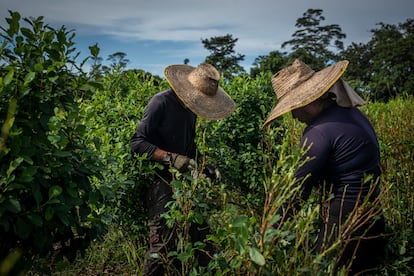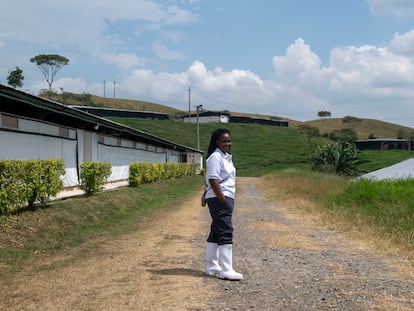Coca provides vital economic support with fleeting benefits for Colombia’s most remote regions
Researchers determine that peasant producers who grow coca leaves have contributed 0.4% growth to the country’s economy

Something is happening in the illegal business of growing coca leaf and selling its paste that takes place in what some call the “invisible Colombia.” These are the lands that extend beyond what sociologists have labelled the country’s agrarian frontiers, where the government’s presence seems nothing more than a distant echo. A group of researchers, largely from Bogota’s University of the Andes, recently published a revealing study on one of the shadiest parts of the Colombian economy, one difficult to map with statistical accuracy. The investigation’s most solid conclusions are threefold. Its main finding is that peasant producers — the first link in the coca supply chain — contributed to a 0.4% growth of the country’s economy during years when it grew by a total average of 3%.
The second finding is that such producers’ local impact is also vital. In small coca-growing municipalities, they provide the backbone of their communities’ livelihood, accounting for around 10.5% of total income in such areas. Finally, the study found that the industry is as lucrative in the short-term as it is unprofitable in the medium and long-term. The business has barely warded off poverty in cultivating regions. In fact, several such areas are currently experiencing a humanitarian crisis and food shortages the likes of which have not been seen in decades. Not to mention that, according to the study, which is entitled Local coca-based growth and its socioeconomic impact in Colombia, coca production has become a voracious synonym for deforestation.
In addition to the environmental damage caused by logging, which is required to extend coca leaf harvests, there has been an accelerated increase in the transition of coca lands to cattle ranches and pastures: “In the Colombian Amazon, the increase was 302% between 2014 and 2019,” says economist Lucas Marín-Llanes, director of the investigation.
This proximity between cattle ranching and coca cultivation has become quite intimate in some parts of Colombia. Among the explanations for this fact is that a significant number of the beneficiaries of state programs geared towards the substitution of illicit crops have opted to transition to livestock farming. “Livestock has some benefits and yields some profitability. It serves as an income stream through the sale of milk and investment for households. But our conclusion is that there is a direct interaction between these two economies and that their promotion has rendered them the main drivers of deforestation in Colombia,” says Marín-Llanes.
The study was published by the Center for Economic Development Studies at the University of the Andes. Its scope does not include trafficking, distribution, export, or money laundering chains associated with the cocaine economy. The latest studies on those activities date back to 2019, when they were estimated to have formed 1.88% of Colombia’s GDP.
Rather, the focus of the latest research, which was conducted during a three-year period, is on the rural production of coca leaves and their transformation into coca paste, an alkaloid that requires the use of chemicals to produce. Marín-Llanes says that as of 2019, the sector has seen significant turnaround. The paralysis in world trade that resulted from the pandemic forced traffickers to rethink their business formula. Colombia experienced an overproduction of coca leaf that resulted in accumulations that still exist in mountains and plots of lands in departments like North Santander, Nariño, and Putumayo, which is located on the border with Ecuador.
Prices plummeted and life in hundreds of municipalities underwent a dramatic metamorphosis. “The socioeconomic consequences have been significant. In boom periods, the municipalities of departments like Caquetá see the opening of stores filled with tennis shoes and clothing from all kinds of brands. Restaurants, clubs, bars and pool halls fill up. But with the fall of prices on the market, there has been an evident impact. Those same places now look deserted, uninhabited, infrastructure is neglected and activity disappears,” says Marín-Llanes.
His words provide an apt portrait for an industry that moves millions of dollars higher up the criminal food chain, but which in the towns and countryside of Colombia’s coca-growing regions, barely sustains a flimsy economic structure. It is clear that, if during certain periods it serves as an economic engine, coca cultivation does not resolve structural roots of vulnerability and marginality in a Colombia that often seems to have been forgotten. “It is the main economic sector in these territories. Even when there are state interventions to tackle it, there are problems. Any shock to a source that produces 10% of GDP generates imbalances in the organization of society,” says Marín-Llanes.
He’s particularly referring to the areas in which coca crops and business have been grown for decades due to their proximity to neighboring countries or maritime trade routes. Clandestine landing strips and docking bays for submarines and other vessels have been found along the Pacific coast in departments like Nariño, Cauca, and Chocó. Coca is also grown in Casanare, Meta, and Guaviare, located in the country’s eastern plains.
Another of the study’s findings contradicts the classic academic perspective that definitively links violence and coca cultivation. As in recent works on the subject, such as those of historian Lina Britto on cannabis, this latest investigation, on which economists María Alejandra Vélez and Manuel Fernández as well as geographer Paulo Murillo-Sandoval also worked, establishes that violence is “neither inherent nor a strategic behavior within organizations and communities that participate in this market,” Marín-Llanes says.
Data collected through the study indicates that during the years of the 2014-2019 coca bonanza, when satellite images suggested that the country was flooded with coca cultivation, violence, as measured by the presence of armed groups, crime rates and homicides, did not increase in associated municipalities.
While his team’s research does not downplay the bloody struggles between criminal groups that today battle over territories and control of production, study co-author Fernández recalls that during the years examined, there was no visible increase in records of forced displacement. “This, perhaps, contrasts with some of the literature that shows a very large association between illicit economies and violence, but the coca boom did not exacerbate this factor.”
That boom is over, although the number of acres used for coca cultivation remains high, according to monitoring agencies such as the UN, and prices of the crop in more than one area remain low, with sales stagnant. What method did researchers use to support their work? “We employed satellite data produced by different sources on the level of luminosity,” explains Fernández. “Increases in luminosity in municipal capitals are highly correlated with changes in economic activity. This information on the amount of light emitted in rural areas over time helped us to relate other statistical processes.”
Marín-Llanes says that the production of each coca leaf is a resource multiplier. “For each additional 0.025 cents in production costs, between 0.029 and 0.057 additional cents are added to the country’s GDP. It generates great liquidity and dynamizes the entire economic panorama of these areas. However, the partial evidence we have, on which we are still working, suggests that the five years of bonanza did not promote structural changes or sustainable development variables in health or human capital,” he concludes.
Sign up for our weekly newsletter to get more English-language news coverage from EL PAÍS USA Edition
Tu suscripción se está usando en otro dispositivo
¿Quieres añadir otro usuario a tu suscripción?
Si continúas leyendo en este dispositivo, no se podrá leer en el otro.
FlechaTu suscripción se está usando en otro dispositivo y solo puedes acceder a EL PAÍS desde un dispositivo a la vez.
Si quieres compartir tu cuenta, cambia tu suscripción a la modalidad Premium, así podrás añadir otro usuario. Cada uno accederá con su propia cuenta de email, lo que os permitirá personalizar vuestra experiencia en EL PAÍS.
¿Tienes una suscripción de empresa? Accede aquí para contratar más cuentas.
En el caso de no saber quién está usando tu cuenta, te recomendamos cambiar tu contraseña aquí.
Si decides continuar compartiendo tu cuenta, este mensaje se mostrará en tu dispositivo y en el de la otra persona que está usando tu cuenta de forma indefinida, afectando a tu experiencia de lectura. Puedes consultar aquí los términos y condiciones de la suscripción digital.
More information
Archived In
Últimas noticias
Most viewed
- Sinaloa Cartel war is taking its toll on Los Chapitos
- Reinhard Genzel, Nobel laureate in physics: ‘One-minute videos will never give you the truth’
- Oona Chaplin: ‘I told James Cameron that I was living in a treehouse and starting a permaculture project with a friend’
- Why the price of coffee has skyrocketed: from Brazilian plantations to specialty coffee houses
- David King, chemist: ‘There are scientists studying how to cool the planet; nobody should stop these experiments from happening’











































